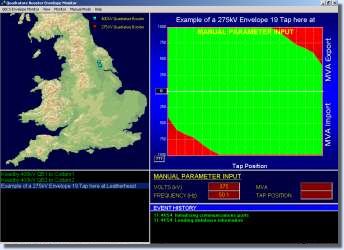
National Grid Transco (or The National Grid Company plc as it was at the time)
is the company responsible to the transmission of electrical energy throughout
England and Wales through the use of its 'National Grid'. The National Grid, was
constructed in the 1960's, linking the electricity generators to the electrical users
via the grid network that consisted of over-head-lines (OHL) and underground cables.
Predominately most of the generation is in the North of the country and most of the
demand (load) is in the South. Because of this, power being transmitted through the
National Grid Network flows in a Southerly direction through the grid network. There
are 4 main routes (overhead lines hung between Pylons or towers in National Grid
speak) in which this energy flows. If all of this energy were to flow down one set
of overhead lines, the lines would ‘overload’ resulting in a fault and ultimately a
power cut. A typical analogy to this would be everyone in the North trying to drive
down the M1 motorway. The road just couldn’t cope if everyone tried doing this at
the same time! A better solution would be to direct some people down the A1 and some
down the M6. Thus, the traffic loading is shared between other routes.
In the electrical world, some clever person worked out a way of wiring two sets of
transformers in such away that it was possible to control the direction in which
power flowed. This device is called a quadrature booster and is very useful in
diverting power through the National Grid network in such away that the power flow
is evenly distributed.
THE CONTROL SYSTEM
The Quadrature Booster device is controlled by changing the tap position on the
transformers. This control was previously achieved using National Grid’s SCADA
network (via the GI74 protocol). One disadvantage with this system was the lack
of monitoring of the Quadrature Booster. This was important because during certain
system frequencies and tap positions, the Quadrature Booster itself could overload.
What was needed was a control system that would monitor the Quadrature Booster and
be capable of interpreting commands sent from the National Control centre. Hence
the Quadrature Booster Control System or QBCS for short was created.
A total of 3 engineers were responsible for the hardware and software required for
this system. My main role was the design, development and coding of the Man-Machine
interface used to drive the QBCS. The software was written in Visual Basic and C++.
Due to cut-backs within the National Grid I was forced to seek new work and Joined
Schaffner EMC Systems Ltd where I continued to develope Windows based applications
(see above). A year or so later, the remaining engineers were made redundant and
set up a new company named Electric-Soft (
http://www.electricsoft.co.uk) where
they continue to develop and support the QBCS software and hardware.